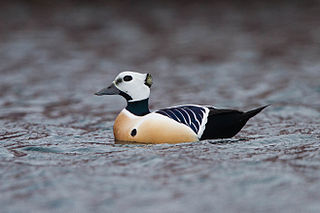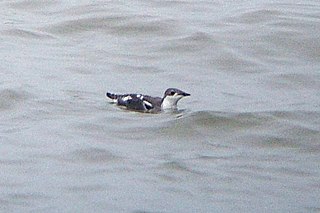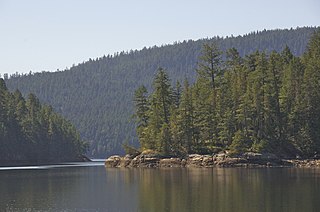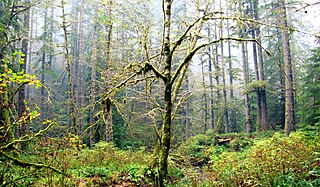Related Research Articles

The true owls or typical owls are one of the two generally accepted families of owls, the other being the barn owls and bay owls (Tytonidae). This large family comprises 230 living or recently extinct species in 24 genera. The Strigidae owls have a cosmopolitan distribution and are found on every continent except Antarctica.

Habitat conservation is a management practice that seeks to conserve, protect and restore habitats and prevent species extinction, fragmentation or reduction in range. It is a priority of many groups that cannot be easily characterized in terms of any one ideology.

Steller's eider is a migrating Arctic diving duck that breeds along the coastlines of eastern Russia and Alaska. It is the rarest, smallest, and fastest flying of the eider species.

The barred owl, also known as the northern barred owl, striped owl or, more informally, hoot owl or eight-hooter owl, is a North American large species of owl. A member of the true owl family, Strigidae, they belong to the genus Strix, which is also the origin of the family's name under Linnaean taxonomy. Barred owls are largely native to eastern North America, but have expanded their range to the west coast of North America where they are considered invasive. Mature forests are their preferred habitat, but they can also acclimatise to various gradients of open woodlands. Their diet consists mainly of small mammals, but this species is an opportunistic predator and is known to prey upon other small vertebrates such as birds, reptiles, and amphibians, as well as a variety of invertebrates.

The spotted owl is a species of true owl. It is a resident species of old-growth forests in western North America, where it nests in tree hollows, old bird of prey nests, or rock crevices. Nests can be between 12 and 60 metres high and usually contain two eggs. It is a nocturnal owl which feeds on small mammals and birds. Three subspecies are recognized, ranging in distribution from British Columbia to Mexico. The spotted owl is under pressure from habitat destruction throughout its range, and is currently classified as a near-threatened species.

The marbled murrelet is a small seabird from the North Pacific. It is a member of the family Alcidae, which includes auklets, guillemots, murres and puffins. It nests in old-growth forests or on the ground at higher latitudes where trees cannot grow. Its population has declined since humans began logging its nest trees in the latter half of the 19th century. The decline of the marbled murrelet and its association with old-growth forests—at least in the southern part of its range—have made it a flagship species in the forest protection movement.

The long-billed murrelet is a small seabird from the North Pacific. The genus name Brachyramphus is from Ancient Greek brakhus, "short", and rhamphos, "bill". The species name perdix is Latin for "partridge" Pallas described this auk as Magnitudine Perdicis. "Murrelet" is a diminutive of "murre", a word of uncertain origins, but which may imitate the call of the common guillemot.

Puget Sound is a deep inlet of the Pacific Ocean in Washington, extending south from the Strait of Juan de Fuca through Admiralty Inlet. It was explored and named by Captain George Vancouver for his aide, Peter Puget, in 1792.
Colonisation or colonization is the spread and development of an organism in a new area or habitat. Colonization comprises the physical arrival of a species in a new area, but also its successful establishment within the local community. In ecology, it is represented by the symbol λ to denote the long-term intrinsic growth rate of a population.

The Headwaters Forest Reserve is a group of old growth coast redwood groves in the Northern California coastal forests ecoregion near Humboldt Bay of the U.S. state of California. Comprising about 7,472 acres (30.24 2), it is managed by the Bureau of Land Management (BLM) as part of the National Landscape Conservation System.

The northern spotted owl is one of three spotted owl subspecies. A western North American bird in the family Strigidae, genus Strix, it is a medium-sized dark brown owl native to the Pacific Northwest. An important indicator species, the northern spotted owl remains threatened due to continued population decline from human-caused habitat destruction and competition with invasive species, its main competitor being the barred owl.

Desolation Sound Marine Provincial Park is a provincial park in British Columbia, Canada located along Desolation Sound. The park is distinguished by its many picturesque sheltered coves and anchorages, frequented by yachts and pleasure craft. The scenery consists of waterfalls, rugged glaciated peaks, and steep forested slopes that fall into the ocean.

Umbrella species are species selected for making conservation-related decisions, typically because protecting these species indirectly protects the many other species that make up the ecological community of its habitat. Species conservation can be subjective because it is hard to determine the status of many species. The umbrella species is often either a flagship species whose conservation benefits other species or a keystone species which may be targeted for conservation due to its impact on an ecosystem. Umbrella species can be used to help select the locations of potential reserves, find the minimum size of these conservation areas or reserves, and to determine the composition, structure, and processes of ecosystems.
The Northwest Forest Plan (NWFP) is a series of federal policies and guidelines governing land use on federal lands in the Pacific Northwest region of the United States. It covers ten million hectares within Western Oregon and Washington, as well as a small part of Northern California.

Aston Rowant National Nature Reserve is located on the north-west escarpment of the Chiltern Hills, in the Chilterns Area of Outstanding Natural Beauty. It has an area of 159.1 hectares, and most of it is a 128.5 hectares biological Site of Special Scientific Interest. It is listed as a Grade 1 site in A Nature Conservation Review. The reserve is in several sections, mostly in the parish of Lewknor in Oxfordshire, with smaller sections in the parish of Stokenchurch in Buckinghamshire.

Elliott State Forest is a state forest in Coos and Douglas counties of the U.S. state of Oregon, between Coos Bay and Reedsport in the Oregon Coast Range. The first state forest established in Oregon, it is named after the state's first state forester Francis Elliott. Trees commonly found in this forest are the Douglas-fir, western hemlock, western redcedar, bigleaf maple, and red alder.

A Habitat Conservation Plan (HCP) is a required part of an application for an Incidental Take Permit, a permit issued under the United States Endangered Species Act (ESA) to private entities undertaking projects that might result in the destruction of an endangered or threatened species. It is a planning document that ensures that the anticipated take of a listed species will be minimized or mitigated by conserving the habitat upon which the species depend, thereby contributing to the recovery of the species as a whole.
Scott Islands Marine National Wildlife Area is a National Wildlife Area off the northwestern tip of Vancouver Island in the Canadian province of British Columbia. Covering an area of 11,570.65 km2 (4,467.45 sq mi), it is the second largest protected area in British Columbia after Offshore Pacific Seamounts and Vents Closure and is the largest national wildlife area in Canada.
The Marine West Coast Forest is a Level I ecoregion of North America designated by the Commission for Environmental Cooperation (CEC) in its North American Environmental Atlas. The region includes parts of Alaska, the Yukon, British Columbia, Washington, Oregon, and California.
References
- ↑ "Independent Science Review in Natural Resource Management: Evaluation's Role in Knowledge Use" (PDF).
- ↑ "EVALUATION OF SCIENTIFIC INFORMATION REGARDING PREBLE'S MEADOW JUMPING MOUSE" (PDF).
- 1 2 "Peeping British Biologist Sentenced". www.independent.com. 17 February 2017. Retrieved 2017-02-28.
- ↑ Courtney, Steven P.; Chen, Glenn K.; Gardner, Alex (1989). "A general model for individual host selection". Oikos. 55 (1): 55–65. doi:10.2307/3565872. JSTOR 3565872.
- ↑ "Scientific Evaluation of the status of the Northern Spotted Owl" (PDF).
- ↑ "The invasion of barred owls and its potential effect on the spotted owl: a conservation conundrum" (PDF).
- ↑ "Bush calls for review of Spotted Owl plan".
- ↑ "Scientific Review of the Draft Northern Spotted Owl Recovery Plan and Reviewer Comments]" (PDF).
- ↑ "Shooting one owl to save another]".
- ↑ Bigger, David; Peery, M. Zachariah; Chinnici, SAL; Courtney, Steven P. (2006). "Efficacy of Audiovisual and Radar Surveys for Studying Marbled Murrelets in Inland Habitats". Journal of Wildlife Management. 70 (2): 505–516. doi:10.2193/0022-541X(2006)70[505:EOAARS]2.0.CO;2. S2CID 39248213.
- ↑ "Managing Second-Growth Forests in the Redwood Region for Accelerated Development of Marbled Murrelet Nesting Habitat" (PDF).
- ↑ "Everglades Multi-Species Avian Ecology And Restoration Review ]" (PDF).
- ↑ "Panel Review of Restoration on the San Acacia Reach, Rio Grande".
- ↑ "Science Review of Testimony in the Delta Smelt Cases Summary Report]" (PDF).
- ↑ "Science Review of Testimony in the Delta Smelt Cases Summary Report]" (PDF).
- ↑ "Investigation clears US interior-department staff of misconduct ]".
- ↑ Morell, V. (2014). "Science Behind Plan to Ease Wolf Protection Is Flawed, Panel Says]". Science. 343 (6172): 719. doi:10.1126/science.343.6172.719. PMID 24531948.
- ↑ "Singapore Airlines Jet Crashes at Taipei Airport ]". ABC News . 2006-01-06.
- ↑ "Singapore Airlines plane bound for L.A. in flames after hitting runway ]".
- ↑ Perrin, Andrew (2000-11-03). "Passenger took control as cabin staff panicked ]".
- ↑ "Birdwatcher Charged with Spying on Houseguests]".